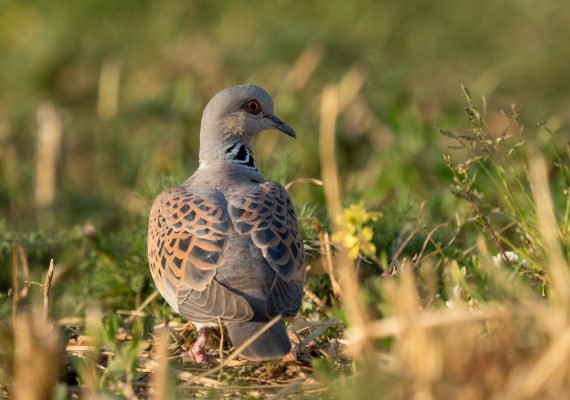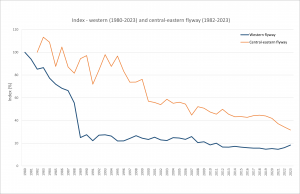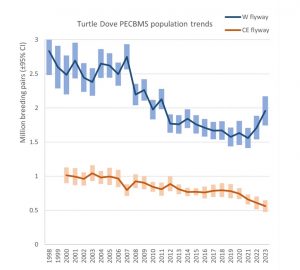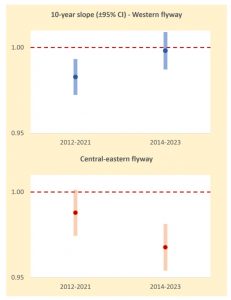
Thanks to the enormous effort of the national coordinators to deliver data till 2023, we have been able to produce the most up-to-date outputs this spring and showed that the Turtle Dove index in the western flyway with working hunting moratoria and restrictions has been improving for the last three years. Photo by Lubo Ondraško
PECBMS’s contribution to the Turtle Dove protection
June 14, 2024
The European Turtle Dove (Streptopelia turtur) breeding numbers show an overall decline, and the species was classified as Vulnerable on the IUCN Red List. The main threats are illegal hunting and trapping, unsustainable hunting levels, habitat loss and intensive agriculture. Therefore, the European Commission induced an International single species action plan for Turtle Dove protection. The PECBMS task within this plan is to impute Turtle Dove flyway-specific indices. Still, the data is also used to create models predicting the population's future development under various conditions.

Thanks to the enormous effort of the national coordinators to deliver data till 2023, we have been able to produce the most up-to-date outputs this spring and showed that the Turtle Dove index in the western flyway with working hunting moratoria and restrictions has been improving for the last three years. Photo by Lubo Ondraško
Turtle Dove protection
The European Turtle Dove (Streptopelia turtur) breeds across most of Europe and migrates on a broad front to sub-Saharan Africa to overwinter. According to the EURING data, the birds use four flyways (Marx et al. 2016). Breeding numbers show an overall decline, and the species was added to Vulnerable on the IUCN Red List. The main threats to the species are illegal hunting and trapping, unsustainable hunting levels in countries where hunting is permitted, habitat loss and intensive agriculture (Fisher et al., 2018). These threats persist, although the Turtle Dove is listed in Annex II of the Birds Directive and Appendix II of the Convention on Migratory Species (CMS).
Therefore, in 2018, an International single species action plan (SAP) for Turtle Dove commenced, aiming to gather available information on the threats and recommend actions that lead to species conservation. Knowledge of the threats gained through the SAP results in establishing an Adaptive Harvest Management (AHM) mechanism, which suggests strategies to optimise the harvest of the species to a sustainable level and eradicate illegal killing. The main aim is to enable the turtle dove population to recover, and environmental measurements are based on the recent population models. Hunting reduction has been identified as a short-term immediate action, while actions to revert the other threats, such as habitat loss, require dedicated work in the long term. Based on these facts, the moratoria and hunting restrictions across the EU countries came into force in 2021 and continued in 2022 and 2023. The restrictions have also been recently prolonged to the year 2024.
PECBMS’s role in the project
The Turtle Dove flyway use plays an important role as a management unit in the context of an Adaptive Harvest Management mechanism. To plan effectively the future conservation actions for the turtle dove, it is necessary to analyse the impact of the current hunting restrictions on the most recent and accurate data possible available for the species’ flyways. Therefore, PECBMS was asked to calculate the flyway index from national data delivered by countries belonging to each flyway for the project Supporting the recovery of bird species of Annex II of the Birds Directive in non-secure conservation status. Due to the PECBMS coverage, we focus only on the two Turtle Dove flyways: the western flyway and the central-eastern flyway. The national coordinators of monitoring schemes listed below this article kindly gave us their permission to use the data and provide us with their Turtle Dove data every year. National indices belonging to certain flyways are gathered, and the flyway index is calculated as a supranational index using the standard PECBMS methods.
Since the moratorium has been running only for three complete years, it is crucial to get the most up-to-date data possible. Therefore, PECBMS asked national coordinators to deliver their Turtle Dove data gained in 2023 already at the end of the previous year. Since most coordinators put enormous effort, we were able to calculate flyway indices till 2023 for the Turtle Dove Task Force meeting held on 19th April 2024. This is a great achievement because we could show for the first time the success or failure of the environmental measures used for turtle dove protection. Moreover, the high quality of the PECBMS data and the effort to deliver up-to-date data improved the respect and trust of these organizations in the PECBMS data. This early data delivery improved plans for the proper steps how to increase the Turtle Dove population in Europe to a level suitable for the survival of species and proper hunting quota.
Success in the western flyway but not in the central-eastern
Given the western flyway, it seems that the hunting restrictions have already positively affected the Turtle Dove population. The flyway index has been slightly increasing in the last two years (2022–2023), and the 2023 index value is even the highest one in the last ten years. This suggests that even a short-term hunting moratorium can help the depleted western flyway population to start growing.
The situation in the central-eastern flyway is, unfortunately, the opposite; the index is persistently decreasing. We might expect this difference could be caused (among other potential factors) by the opposite attitude of countries laying in the flyways to the hunting moratoria. While the majority of countries in the western flyway stopped or dramatically reduced hunting, only a few countries in the central-eastern flyway reduced their hunting effort.
Future of the Turtle Dove
The first part of the project, Supporting the recovery of bird species of Annex II of the Birds Directive in non-secure conservation status, shall be finished in the year 2025. The final decision on hunting restrictions sustainable for the Turtle Dove population in the next years will be taken into consideration. These decisions will be taken on the basis of PECBMS flyway indices and models predicting Turtle Dove population development under various scenarios.
Comparison of western and central-eastern flyway development
Fig 1. Graph western flyway till 2023. It seems that the hunting restrictions have already positively affected the Turtle Doves. The index has been slightly increasing in the last three years.

Fig. 2. Estimates of Turtle Dove breeding population size along the European part of the western flyway 1998–2023 and central-eastern flyway 2000–2023. Estimates of the number of breeding pairs in each flyway were calculated by combining information on annual variations in national bird count data during surveys and information on population sizes reported by national authorities in the latest Art. 12 process. Error bars indicate 95% confidence intervals. Data: PECBMS (February 2024).

Fig. 3. The 10-year multiplicative slopes for both flyways correspond to 2012–2021 and 2014–2023 with their 95% confidence intervals. The red dotted line marks population stability (λ= 1). As explained in the text, in the western flyway, the 10-year slope has improved from moderate decline (confidence interval lower than one but higher than 0.95) to stable (confidence interval crosses 1). In the central-eastern flyway, the opposite situation occurs, with the 10-year slope worsening from stable to moderate decline. Data: PECBMS (February 2024).

Eva Šilarová, Jana Škorpilová and Alena Klvaňová
Literature:
Marx, M., Korner-Nievergelt, F. & Quillfeldt, P. 2016. Analysis of ring recoveries of European Turtle Doves Streptopelia turtur—Flyways, migration timing and origin areas of hunted birds. Acta Ornithol. 51: 55–70.
Fisher, I., Ashpole, J., Scallan, D., Proud, T. & Carboneras, C. 2018. International Single Species Action Plan for conserving the European Turtle-dove Streptopelia turtur (2018 to 2028). Luxemb. Eur. Comm.
Carboneras, C., Cruz-Flores, M., Colomer, M.À., Šilarová, E., Škorpilová, J. & Arroyo, B. 2024. Turtle Dove Adaptive Harvest Management mechanism – March 2024 Technical update. Report to the EU Task Force on the Recovery of Birds. Brussels, April 2024.
Western flyway
Central-eastern flyway
Technical recommendations
The PECBMS thanks for the data provided by the following national coordinators:
Austria: Benjamin Seaman, Norbert Teufelbauer (Monitoring der Brutvögel Österreichs), Belgium: Antoine Derouaux, Jean-Yves Paquet, Glenn Vermeersch (Common Breeding Birds Flanders & Common Breeding Birds Survey in Wallonia – Le suivi des oiseaux communs en Wallonie (SOCWAL)), Bulgaria: Iordan Hristov, Georgi Popgeorgiev (Мониторинг на обикновените видове птици – Common Bird Monitoring Scheme), Croatia: Ivan Budinski, Dubravko Dender, Vlatka Dumbović Mazal, Iva Mihalić, Mate Zec (Monitoring čestih vrsta ptica poljoprivrednih staništa u Hrvatskoj – Common Farmland Bird Monitoring in Croatia), Cyprus: Christina Ieronymidou, Stalo Leontiou (Πρόγραμμα Παρακολούθησης Κοινών Πουλιών – Common Birds Monitoring Scheme), Czechia: Jiří Reif, Zdeněk Vermouzek, Petr Voříšek (Jednotný program sčítání ptáků (JPSP) – Breeding Bird Census Programme), Estonia: Meelis Leivits (KAUR), Renno Nellis (EOÜ – point count project), France: Benoît Fontaine, Frédéric Jiguet, Romain Lorrillière, Lorraine Delthel (Suivi Temporel des Oiseaux Communs (STOC) – French Breeding Bird Survey (FBBS)), Germany: Malte Busch, Martin Flade, Bettina Gerlach, Johannes Schwarz, Sven Trautmann (German Common Breeding Bird Survey & German Common Bird Census), Greece: Aris Manolopoulos, Danae Portolou (Πρόγραμμα Παρακολούθησης των Κοινών Ειδών Πουλιών της Ελλάδας – Hellenic Common Bird Monitoring Scheme (HCBM)), Hungary: Zoltán Görögh, Károly Nagy, Tibor Szép (Mindennapi Madaraink Monitoringja (MMM) – Monitoring of our common birds), Italy: Mattia Brambilla, Gianpiero Calvi, Simonetta Cutini, Laura Silva (MITO2000 – Monitoraggio ITaliano Ornitologico), Latvia: Ainārs Auniņš, Oskars Keišs, Ieva Mārdega, Dagnis Vasilevskis (Latvijas ligzdojošo putnu uzskaites – Latvian Breeding Bird Monitoring scheme), Lithuania: Petras Kurlavičius, Renata Mackevičienė (Įprastų paukščių populiacijų gausos stebėsena (ĮPGS) – Lithuanian Common Bird Monitoring scheme), Netherlands: Arjan Boele, Joost van Bruggen, Adriaan Gmelig Meyling, Dorine Jansen, Chris van Turnhout, Jan-Willem Vergeer (BMP A – All breeding bird species project), Poland: Tomasz Chodkiewicz, Przemysław Chylarecki, Łukasz Wardecki (Monitoring Pospolitych Ptaków Lęgowych (MPPL) – Common Birds Survey), Portugal: Hany Alonso, Rúben Coelho, Cátia Gouveia, Guillaume Réthoré (Censo de Aves Comuns – Common Bird Census), Romania: Zoltán Benkő, Cristi Domșa, Ede Gábos, Zoltán D. Szabó, Judit Veres-Szászka (Monitorizarea Pãsãrilor Comune (MPC) – Common Bird Monitoring (CBM)), Slovakia: Jozef Ridzoň, Ján Topercer (Monitoring of breeding bird populations in Slovakia), Slovenia: Matej Gamser, Primož Kmecl (Slovenski monitoring pogostih ptic kmetijske krajine – Slovene monitoring of common farmland birds), Spain: Virginia Escandell, Emilio Escudero, Juan Carlos del Moral (Common Breeding Bird Monitoring Scheme (SACRE)), Switzerland: Christian Rogenmoser, Hans Schmid, Martin Spiess, Nicolas Strebel, Samuel Wechsler (Monitoring Häufige Brutvögel – Monitoring of common breeding birds), United Kingdom: James Heywood, Dario Massimino, David Noble (Breeding Bird Survey & Common Birds Census).